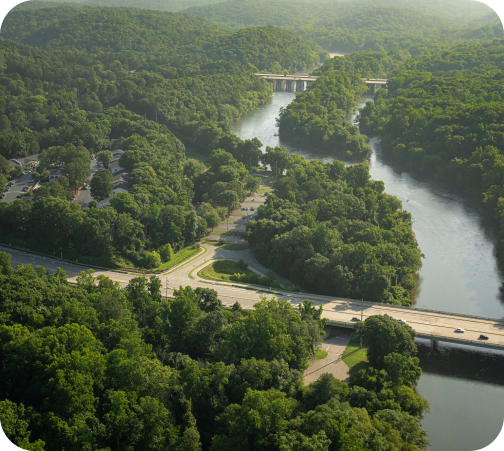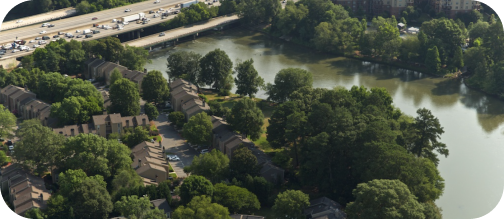FAQs
Find answers to common questions about the New Day Palisades project, including details about the rehabilitation efforts, how you can get involved, and more.
Designated by President Jimmy Carter in 1978, the Chattahoochee River National Recreation Area (CRNRA) is a 7,000-acre unit of the national park system stretching from Lake Lanier to the city of Atlanta that is managed by the National Park Service. The 48-mile section of the Chattahoochee River boasts over 66 miles of trails and offers access to historic sites and a variety of recreation opportunities including hiking, fishing, paddling, picnicking, and wildlife-watching. It is the 29th most visited national park in the country.
Paces Mill in the Palisades Unit is part of the Chattahoochee River National Recreation Area (CRNRA) in Atlanta, Georgia. Built in 1978, this park unit is a popular destination for recreational activities like boating, fishing, picnicking, jogging, biking, and walking. It hosts over 270,000 visitors annually, connecting to 38 miles of multi-use trails and serving as the Bob Callan Trailhead.
New Day Palisades is a $15.8 million project led by One Cumberland in partnership with the Cumberland CID, and the National Park Service to renew and rehabilitate the Palisades Land Unit at Paces Mill, a beloved part of the Chattahoochee River National Recreation Area (CRNRA) that hosts more than 270,000 visitors each year. Since its designation in 1978, the unit has fallen into a state of disrepair and requires restoration investments to preserve the park for future generations. New Day Palisades construction includes a new parking lot and picnic area, increased river access, and a visitor information center complete with restrooms, changing facilities, and an open-air pavilion.
Phase One of New Day Palisades is a $6.3 million project that broke ground in fall 2024 and completed in spring 2025. This phase focused on conducting site work, increasing the site’s sustainability, and improving visitor circulation and safety. During this phase, Paces Mill underwent critical demolition, grading, and erosion control projects, including the addition of a meadow and bioswales to enhance environmental resiliency and a stronger sense of arrival to the park. Improved vehicular circulation, including a redesigned bus parking area, will better serve the unit’s 270,000 annual visitors. Upgrades were made to the existing trail system including green infrastructure and current best practices for stormwater management to improve drainage and reduce flooding risk.
Phase Two of New Day Palisades is a $9.5 million project scheduled to break ground in fall 2026 with an anticipated completion in spring 2027. This phase is not funded and will have a significant impact on community access to and engagement with the river and trails, creating a distinct national park experience. The new visitor information center will be the centerpiece of Phase Two projects, featuring new restrooms, changing facilities, and an open-air pavilion. The ADA-compliant center will have dedicated space for interactive exhibits about Paces Mill and the Chattahoochee River National Recreation Area along with other environmental exhibits. Phase Two will enhance river activation by converting the existing riprap on the riverbank – designed to slow stormwater entering the river – into wide river steps and seating under the U.S. 41 overpass to complement the landscape and create a new space for gathering, reflection, and connection with nature. Additional elevated overlooks will be constructed for wildlife viewing along the boardwalk to increase connectivity to the river. Lastly, Phase Two will benefit boaters, rafters, and kayakers by supporting improved parking circulation at a redesigned takeout area for boats.
One Cumberland is a non-profit organization established by the Cumberland Community Improvement District (CID) that centers around the 6.5-mile Cumberland district in southern Cobb County, Georgia. Its mission is to protect and conserve the natural resources of Cumberland and establish the district as a vibrant, diverse community through the enrichment of cultural amenities, quality of life, improved access, and environmental stewardship. By expanding their impact, One Cumberland supports Cumberland CID’s work in creating and maintaining a thriving community.
The Cumberland Community Improvement District (CID), Georgia’s inaugural CID, is a public-private assessment district covering approximately 6.5 square miles in southern Cobb County, Georgia. It encompasses the intersections of I-75, I-285, and U.S. Highway 41. Since its establishment in 1988, commercial property owners have paid an additional property tax, which the Cumberland CID leverages to advance key projects aimed at increasing access, connectivity, and vibrant character throughout the Cumberland area. With over $180 million invested and committed in local improvements, Cumberland has a $26.6 billion annual impact on Georgia’s economy.
Designated by President Jimmy Carter in 1978, the Chattahoochee River National Recreation Area (CRNRA) is a 7,000-acre unit of the national park system stretching from Lake Lanier to the city of Atlanta that is managed by the National Park Service. The 48-mile section of the Chattahoochee River boasts over 66 miles of trails and offers access to historic sites and a variety of recreation opportunities including hiking, fishing, paddling, picnicking, and wildlife-watching. It is the 29th most visited national park in the country.
Paces Mill in the Palisades Unit is part of the Chattahoochee River National Recreation Area (CRNRA) in Atlanta, Georgia. Built in 1978, this park unit is a popular destination for recreational activities like boating, fishing, picnicking, jogging, biking, and walking. It hosts over 270,000 visitors annually, connecting to 38 miles of multi-use trails and serving as the Bob Callan Trailhead.
New Day Palisades is a $15.8 million project led by One Cumberland in partnership with the Cumberland CID, and the National Park Service to renew and rehabilitate the Palisades Land Unit at Paces Mill, a beloved part of the Chattahoochee River National Recreation Area (CRNRA) that hosts more than 270,000 visitors each year. Since its designation in 1978, the unit has fallen into a state of disrepair and requires restoration investments to preserve the park for future generations. New Day Palisades construction includes a new parking lot and picnic area, increased river access, and a visitor information center complete with restrooms, changing facilities, and an open-air pavilion.
Phase One of New Day Palisades is a fully-funded $6.3 million project that broke ground in fall 2024 and completed in spring 2025. This phase focused on conducting site work, increasing the site’s sustainability, and improving visitor circulation and safety. During this phase, Paces Mill underwent critical demolition, grading, and erosion control projects, including the addition of a meadow and bioswales to enhance environmental resiliency and a stronger sense of arrival to the park. Improved vehicular circulation, including a redesigned bus parking area, will better serve the unit’s 270,000 annual visitors. Upgrades were made to the existing trail system including green infrastructure and current best practices for stormwater management to improve drainage and reduce flooding risk. Additional elevated overlooks were constructed for wildlife viewing along the boardwalk to increase connectivity to the river.
Paces Mill was closed for Phase One Construction from fall 2024 until spring 2025. The Park reopened on Memorial Day weekend 2025. Closure for Phase Two will be announced in 2026.
Trails will remain open throughout the Palisades but access from Paces Mill to those trails will not be permitted. Trails must be accessed at other locations other than Paces Mill.
The southern and western boat ramp is located west of Cobb Parkway/U.S. 41 and will remain open in Phase One. However, due to limited parking, water activities are discouraged.
Phase Two of New Day Palisades is a $9.5 million project scheduled to break ground in fall 2026 with an anticipated completion in spring 2027. This phase is not funded and will have a significant impact on community access to and engagement with the river and trails, creating a distinct national park experience. The new visitor information center will be the centerpiece of Phase Two projects, featuring new restrooms, changing facilities, and an open-air pavilion. The ADA-compliant center will have dedicated space for interactive exhibits about Paces Mill and the Chattahoochee River National Recreation Area along with other environmental exhibits. Phase Two will enhance river activation by converting the existing riprap on the riverbank – designed to slow stormwater entering the river – into wide river steps and seating under the U.S. 41 overpass to complement the landscape and create a new space for gathering, reflection, and connection with nature. Lastly, Phase Two will benefit boaters, rafters, and kayakers by supporting improved parking circulation at a redesigned takeout area for boats.
One Cumberland is a non-profit organization established by the Cumberland Community Improvement District (CID) that centers around the 6.5-mile Cumberland district in southern Cobb County, Georgia. Its mission is to protect and conserve the natural resources of Cumberland and establish the district as a vibrant, diverse community through the enrichment of cultural amenities, quality of life, improved access, and environmental stewardship. By expanding their impact, One Cumberland supports Cumberland CID’s work in creating and maintaining a thriving community.
The Cumberland Community Improvement District (CID), Georgia’s inaugural CID, is a public-private assessment district covering approximately 6.5 square miles in southern Cobb County, Georgia. It encompasses the intersections of I-75, I-285, and U.S. Highway 41. Since its establishment in 1988, commercial property owners have paid an additional property tax, which the Cumberland CID leverages to advance key projects aimed at increasing access, connectivity, and vibrant character throughout the Cumberland area. With over $180 million invested and committed in local improvements, Cumberland has a $26.6 billion annual impact on Georgia’s economy.
Beyond Paces Mill
As we revitalize Paces Mill, there are many other beautiful places to walk, ride, kayak, swim, and enjoy the river. Here are a few of our favorites.
Additional Resources
See more fact sheets, articles, and resources with in-depth project information, goals, and benefits of New Day Palisades.
Support our mission
Our mission is to restore and enhance Paces Mill, fostering a deeper connection between the community and the natural environment.







